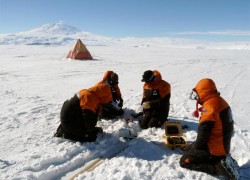
U. Utah mathematics professor Ken Golden hopes to be able to predict the effects of global warming and to create an improved climate model by studying polar sea ice.
Golden has been studying the fluid permeability of sea ice, which is a measure of how easily brine—produced from high concentrations of sodium chloride—moves through the ice. This liquid laces itself throughout the ice structure of the water when it becomes frozen.
“When the volume fraction of brine inclusions is below 5 percent, the sea ice becomes impermeable to flow, whereas when it exceeds 5 percent, pathways throughout the ice are created which allows fluid to travel through,” Golden said.
Golden has named this the Rule of Five, as 5 percent is a critical point, acting like an on-off switch for fluid flow.
“The important processes happening within the ice structures are not properly being accounted for in the latest computer models—the importance of our work is to improve the predictions of the sea ice’s response to global warming, which, in turn, will help us to develop a reliable climate model,” Golden said.
The Arctic Ocean has one of the densest degrees of sea life present. The complex food webs beneath the ocean’s surface affect the algae that live inside the fluid inclusions.
“Nutrients are supplied to this algae through this water movement when it flows through the pathways, which is all controlled by the Rule of Five,” he said.
Golden has worked alongside Cynthia Furse, professor of electrical and computer engineering, in developing the project.
“We wrote this proposal together several years ago, both recognizing that engineering was important for practical and theoretical aspects,” Furse said. “We make a great team.”
Golden and his team will explore electrical elements of ice in May on a new expedition to the Arctic, funded by the National Science Foundation.
“We are doing all the mathematics behind this to develop theoretical models in order to understand the sea levels—which are sometimes difficult to do,” Golden said.
